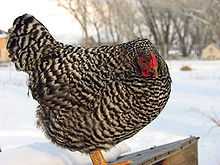Dominique (chicken)
| Dominique | |
|---|---|
 A Dominique cockerel (6 months old, center). | |
| Conservation status | Watch |
| Nicknames |
Dominickers Pilgrim Fowls |
| Country of origin | United States |
| Traits | |
| Weight | Male: 7 lbs. |
| Female: 5 lbs. | |
| Skin color | Yellow |
| Egg color | Brown |
| Comb type | Rose |
| Classification | |
| APA | American |
| ABA | Rose Comb, Clean Legged |
| Notes | |
| Dual purpose breed | |
|
Chicken Gallus gallus domesticus | |
The Dominique, also known as Dominicker or Pilgrim Fowl, is a breed of chicken (Gallus gallus domesticus) originating in the United States during the colonial period. It is considered America's oldest breed of chicken,[1] probably descending from chickens brought to New England from southern England during colonial times. By the 19th century, they were widely popular and were raised in many parts of the country. Dominiques are a dual purpose breed, being valued for their meat as well as for their brown eggs. They weigh 6 to 8 pounds (2.7 to 3.6 kg) at maturity. In earlier times, their feathers were much sought after as stuffing for pillows and mattresses.
Appearance


Dominiques are quite distinctive in appearance. They have a rose comb and a heavy plumage of irregularly striped black-and-white feathers (a pattern called "barring" or sometimes "hawk coloring"). The breed matures quickly, producing eggs at about six months of age.
At first glance, Dominiques and Barred Rocks appear strikingly similar, often leading to confusion when discerning a particular breed. The strongest indicators are the comb, plumage, and color.
- Comb
Dominiques possess a rose comb while Barred Rocks possess a single comb. This is generally the most obvious difference.
- Plumage
Dominiques exhibit staggered barring in their plumage, lending to a somewhat mottled appearance. Barred Rocks exhibit crisp, parallel barring.
- Color
Dominiques exhibit a softer contrast of "not quite black on not quite white", while Barred Rocks exhibit a high-contrast black-on-white color.
Approximate weight
| Cock | 3.2 kg | 7.0 lbs |
| Hen | 2.3 kg | 5.0 lbs |
Disposition and behavior
Dominique hens tend to be calm, personable birds (a desirable trait in an egg production bird). Their calm, steady demeanor makes them successful as show birds or family pets. However, Dominique roosters can sometimes be even more aggressive than the Rhode Island Red and have been known to kill small cats, snakes, and even mink.
The hens tend to be good mothers, brooding and raising chicks with a high rate of success.
The Dominique is hardy and a good forager, traits which are attributed to the harsh conditions in which the breed first developed.
History
After the Plymouth Rock breed was developed from the Dominiques in the 1870s, the Dominiques' popularity declined, until by 1950 they were so rare as to be considered nearly extinct. During the 1970s, Dominiques were listed in "Critical" status by the American Livestock Breeds Conservancy, with fewer than 500 breeding birds in North America. However, due to a revival of interest in them and other rare breeds, the Dominiques have made a comeback and are now listed on the "Watch" list, indicating lesser danger of extinction.
See also
Notes
- ↑ Beranger, Jeannette (Spring, 2013), Out Here, Issue no. 35; America's First Chicken, Brentwood, Tennessee: Tractor Supply Co., p. 25.
References
- Beranger, Jeannette (2013). Out Here; America's First Chicken. Brentwood, Tennessee: Tractor Supply Co.
- Ekarius, Carol (2007). Storey's Illustrated Guide to Poultry Breeds. 210 MAS MoCA Way, North Adams MA 01247: Storey Publishing. ISBN 978-1-58017-667-5.
- Percy, Pam (2006). The Field Guide to Chickens. Suite 200, 380 Jackson St, St Paul MN 55101: Voyageur Press. ISBN 0-7603-2473-5.
- Staples, Tamara; Tamara Staples (2001). The Fairest Fowl. 85 Second Street San Francisco CA 94105: Chronicle Books LLC. ISBN 0-8118-3137-X.
- "Othala Acres - Chickens". Retrieved 2008-08-25.
External links
| Wikimedia Commons has media related to Dominique chicken. |